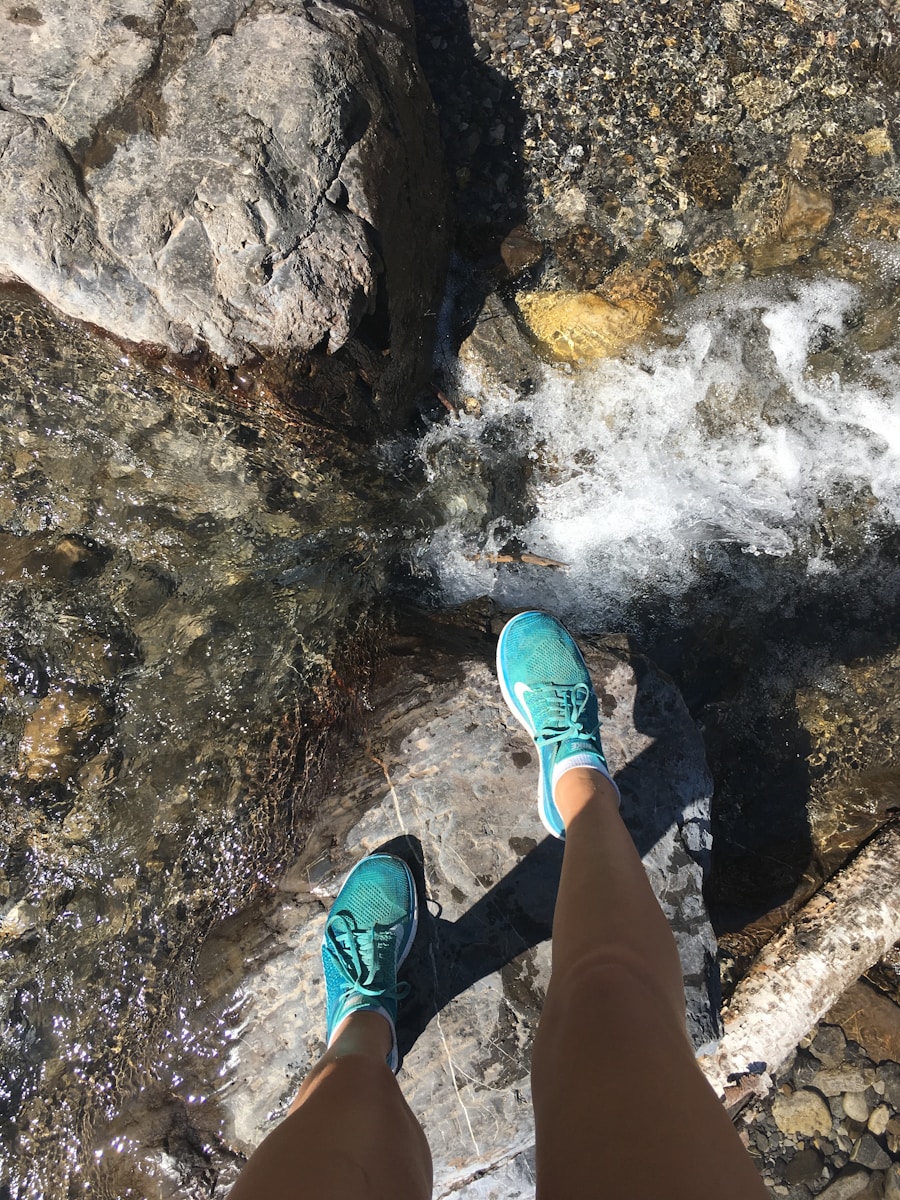Hiking shoes and running shoes are designed with distinct purposes in mind, which is reflected in their construction, materials, and features. Running shoes are primarily engineered for forward motion on paved or well-maintained surfaces. They typically feature a lightweight design, ample cushioning, and a flexible sole that promotes a natural running gait.
The upper part of running shoes is often made from breathable mesh materials to enhance ventilation and keep the feet cool during intense workouts. Additionally, running shoes usually have a more pronounced heel-to-toe drop, which aids in the biomechanics of running by providing support during the heel strike phase. In contrast, hiking shoes are built to withstand rugged terrains and provide stability and traction on uneven surfaces.
They often have a stiffer sole compared to running shoes, which helps in navigating rocky paths and steep inclines. The materials used in hiking shoes are generally more durable and water-resistant, designed to protect the feet from the elements and rough conditions. Hiking shoes also tend to have a more robust tread pattern to enhance grip on various surfaces, including mud, gravel, and wet rocks.
The fit of hiking shoes is usually more secure around the ankle to provide additional support, which is crucial when carrying a backpack or traversing challenging landscapes.
Key Takeaways
- Hiking shoes are designed for stability and support on uneven terrain, while running shoes are designed for flexibility and cushioning on flat surfaces.
- Running in hiking shoes can provide better traction and protection on rugged trails, reducing the risk of slipping and injury.
- Hiking shoes are typically heavier and less breathable than running shoes, which can lead to discomfort and fatigue during long runs.
- When choosing hiking shoes for running, look for lightweight and breathable options with good traction and support.
- Transitioning from running shoes to hiking shoes should be done gradually to allow the feet and muscles to adjust to the different support and cushioning.
The Benefits of Running in Hiking Shoes
Running in hiking shoes can offer several advantages, particularly for those who enjoy trail running or navigating uneven terrains. One of the primary benefits is the enhanced stability that hiking shoes provide. The firmer sole and supportive structure can help prevent ankle rolls and provide a solid base for runners who encounter rocks, roots, or other obstacles on the trail.
This added stability can be particularly beneficial for individuals who may have previously experienced ankle injuries or those who are new to trail running. Another significant advantage of using hiking shoes for running is their durability. Hiking shoes are constructed to endure harsh conditions, which means they can withstand the wear and tear associated with trail running better than traditional running shoes.
This durability can translate into a longer lifespan for the footwear, making them a cost-effective option for avid outdoor enthusiasts. Additionally, the rugged tread patterns found on hiking shoes can offer superior traction on slippery or uneven surfaces, allowing runners to maintain their footing even in challenging weather conditions.
The Drawbacks of Running in Hiking Shoes

While there are benefits to running in hiking shoes, there are also notable drawbacks that potential users should consider. One of the primary concerns is weight; hiking shoes tend to be heavier than running shoes due to their robust construction and additional materials designed for protection and durability. This extra weight can lead to fatigue over longer distances, particularly for runners who are accustomed to the lightweight feel of traditional running footwear.
Another drawback is the flexibility of the shoe. Running shoes are designed to allow for a natural range of motion in the foot, promoting an efficient running stride. Hiking shoes, on the other hand, often have stiffer soles that can restrict this natural movement.
This rigidity may lead to discomfort during longer runs or when transitioning between different types of terrain. Additionally, the cushioning in hiking shoes may not be as responsive as that found in dedicated running shoes, potentially resulting in less shock absorption during high-impact activities like running.
Tips for Choosing the Right Hiking Shoes for Running
| Factors to Consider | Importance |
|---|---|
| Fit | Very Important |
| Support | Very Important |
| Traction | Important |
| Waterproofing | Important |
| Weight | Important |
| Durability | Important |
When selecting hiking shoes for running, it is essential to consider several factors to ensure optimal performance and comfort. First and foremost, fit is crucial; the shoe should feel snug but not overly tight, allowing for some movement of the toes while still providing support around the heel and midfoot. Trying on shoes at the end of the day when your feet are slightly swollen can help you find a more accurate fit.
Another important aspect to consider is the type of terrain you will be running on. If you plan to tackle rocky trails or steep inclines, look for hiking shoes with a more aggressive tread pattern for better grip and stability. Conversely, if your runs will primarily take place on smoother paths or dirt trails, a less aggressive tread may suffice.
Additionally, consider the weather conditions you typically encounter; waterproof or water-resistant materials can be beneficial if you often run in wet environments.
How to Properly Transition from Running Shoes to Hiking Shoes
Transitioning from running shoes to hiking shoes requires a thoughtful approach to ensure comfort and prevent injury. Start by gradually incorporating hiking shoes into your routine rather than making an abrupt switch. Begin with shorter runs on familiar trails where you can assess how your feet respond to the different footwear.
This gradual adjustment allows your feet and legs to adapt to the new shoe dynamics without overwhelming them. Pay attention to how your body feels during these initial runs. If you experience discomfort or pain, it may be necessary to adjust your lacing technique or consider different models that better suit your foot shape and running style.
Additionally, it’s wise to monitor your mileage; as you become more accustomed to hiking shoes, you can slowly increase your distance while ensuring that your body is adapting well to the change.
The Importance of Proper Footwear for Outdoor Activities

Proper footwear is paramount for outdoor activities, as it directly impacts performance, safety, and overall enjoyment. Wearing inappropriate footwear can lead to various issues such as blisters, calluses, or even more severe injuries like sprains or fractures. For instance, inadequate support during hiking can result in foot fatigue or instability on uneven ground, increasing the risk of falls.
Moreover, appropriate footwear can enhance your experience by providing comfort and confidence while navigating diverse terrains. When your feet are well-supported and protected from environmental elements—such as water, mud, or sharp rocks—you can focus more on enjoying your surroundings rather than worrying about discomfort or potential injuries. Investing in quality footwear tailored to your specific outdoor activities is essential for both performance and safety.
Understanding the Versatility of Hiking Shoes for Various Activities
Hiking shoes are not only suitable for hiking but also offer versatility for various outdoor activities beyond traditional trail walking. Their sturdy construction makes them ideal for activities such as light backpacking, where additional support is necessary due to heavier loads. The durability of hiking shoes also makes them suitable for activities like scrambling over rocky surfaces or engaging in outdoor sports that require stability and grip.
Additionally, many people find hiking shoes effective for casual wear or everyday activities that involve walking on varied surfaces. Their rugged design often translates well into urban environments where cobblestones or uneven sidewalks may be present. This versatility allows outdoor enthusiasts to seamlessly transition from trail adventures to everyday errands without needing to change footwear.
Exploring Alternative Uses for Hiking Shoes Beyond Hiking and Running
Beyond their primary functions of hiking and running, hiking shoes can serve various alternative purposes that capitalize on their unique features. For instance, they can be an excellent choice for gardening or landscaping tasks where foot protection is necessary against sharp tools or uneven ground. The sturdy soles provide stability while kneeling or bending down, making them practical for outdoor work.
Moreover, hiking shoes can be beneficial for travel adventures that involve walking through diverse environments—such as city tours that include parks or nature reserves—where comfort and support are essential. Their lightweight yet durable nature makes them suitable for packing into luggage without adding excessive weight while ensuring that travelers are prepared for spontaneous outdoor excursions. This adaptability highlights how hiking shoes can extend their utility beyond traditional outdoor activities into everyday life scenarios where comfort and support are paramount.
If you’re looking for the best lightweight laptop for travel, be sure to check out this article for some great recommendations. And while you’re at it, don’t forget to read up on the terms and conditions of your favorite travel websites. And if you’re in need of some gift ideas for the women in your life who love to travel, be sure to browse through this list of the best travel gifts for women.
Love travel? Join Our Facebook Community For More Tips.
FAQs
What are hiking shoes?
Hiking shoes are a type of footwear designed for outdoor activities such as hiking, trekking, and walking on uneven terrain. They are typically lightweight, durable, and provide good traction and support for the feet.
Can you run in hiking shoes?
While hiking shoes are designed for walking and hiking, some people may find them suitable for light trail running. However, they are not specifically designed for running and may not provide the same level of support and cushioning as running shoes.
What are the differences between hiking shoes and running shoes?
Hiking shoes are designed to provide stability and support on uneven terrain, with features such as a rugged outsole, protective toe cap, and ankle support. Running shoes, on the other hand, are designed for forward motion and typically have more cushioning and flexibility to absorb impact.
Are there specific hiking shoes designed for running?
Some outdoor footwear brands offer hiking shoes that are designed with features suitable for both hiking and running. These hybrid shoes may provide a balance of stability, support, and cushioning for both activities.
What should I consider when choosing hiking shoes for running?
If you plan to run in your hiking shoes, consider factors such as the terrain you will be running on, the level of cushioning and support you need, and the overall fit and comfort of the shoes. It’s important to try on different styles and brands to find the best option for your running needs.
